Abstract
Human T cells that recognize a major epitope of the hepatitis B surface antigen were studied for their ability to react with antigen when presented by mouse fibroblasts that express class II products of the human major histocompatibility gene complex after gene transfection. L cells expressing HLA-DPw4, but not those expressing HLA-DR4 or HLA-DR7, induced strong proliferative responses of antigen-specific T cells to either hepatitis B surface antigen or the synthetic peptide S1d, which bears the immunodominant T-cell epitope. These results identified a genetic restriction element of human helper T-lymphocyte responses to a major antigenic determinant of hepatitis B virus and might be important in the design of subunit vaccines to this pathogen. Peptides that induce T-cell responses that are restricted by a frequently encountered major histocompatibility complex molecule in the general population such as DPw4 would be ideal candidates as subunit vaccines.
Full text
PDF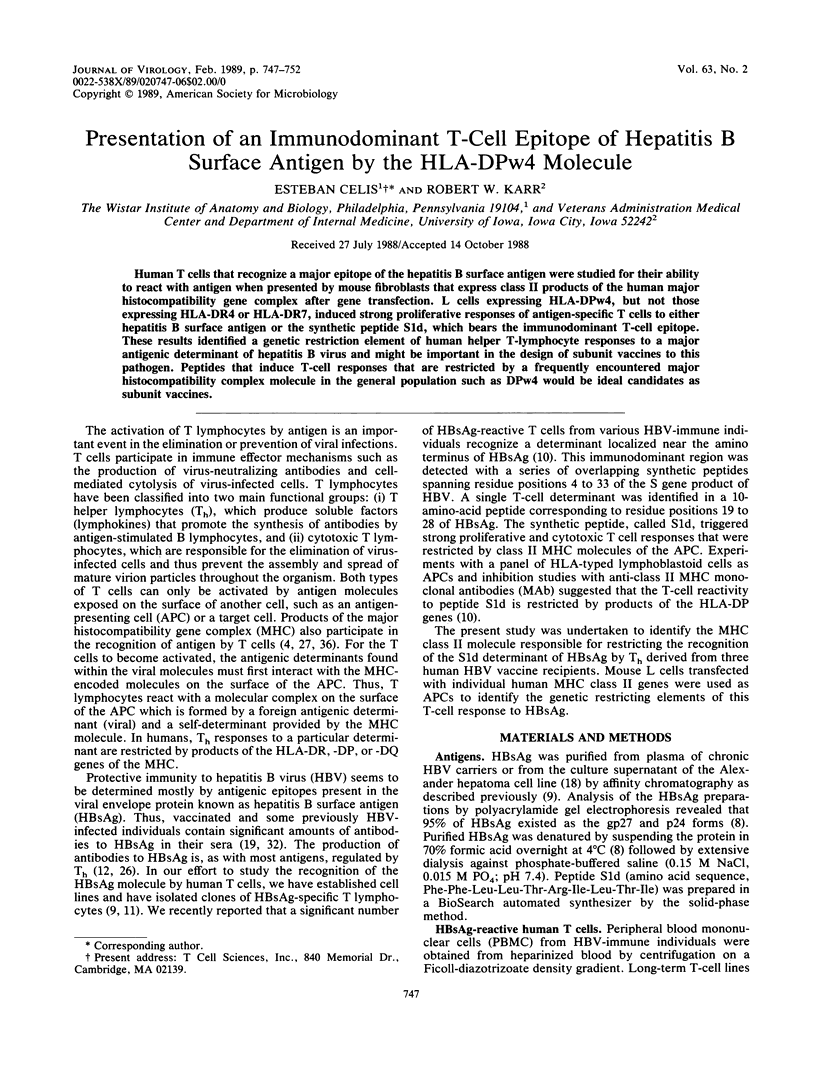
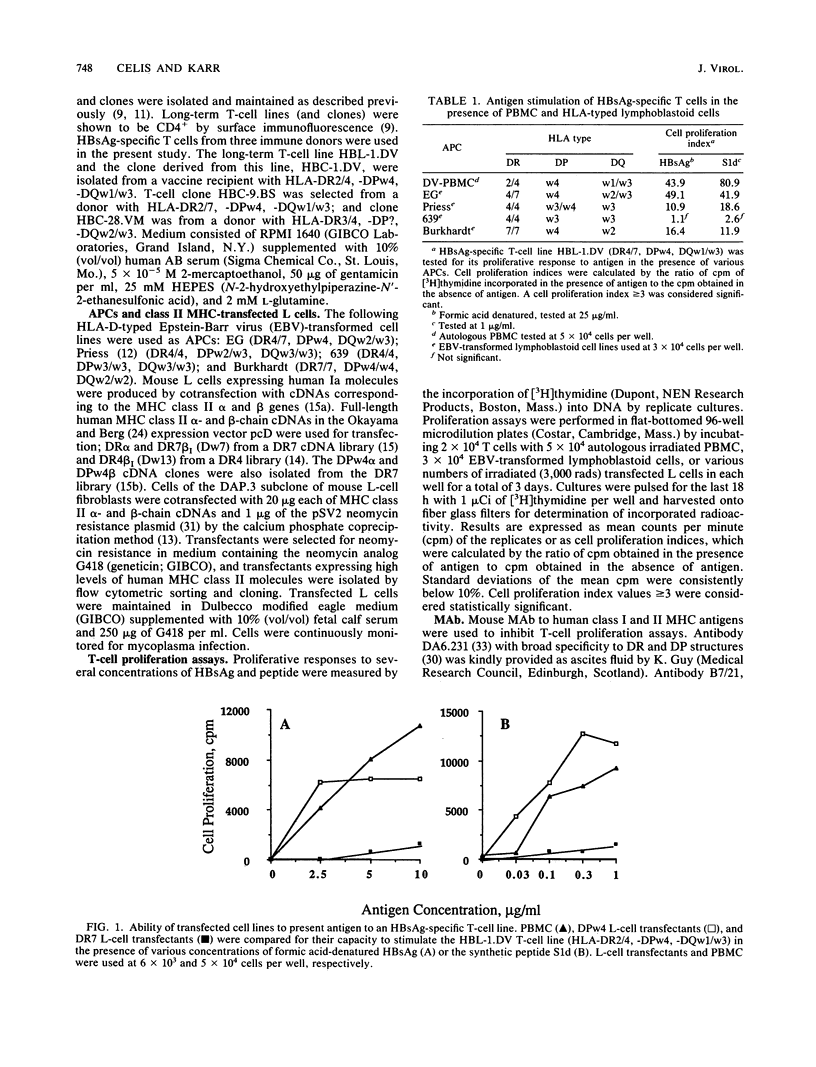
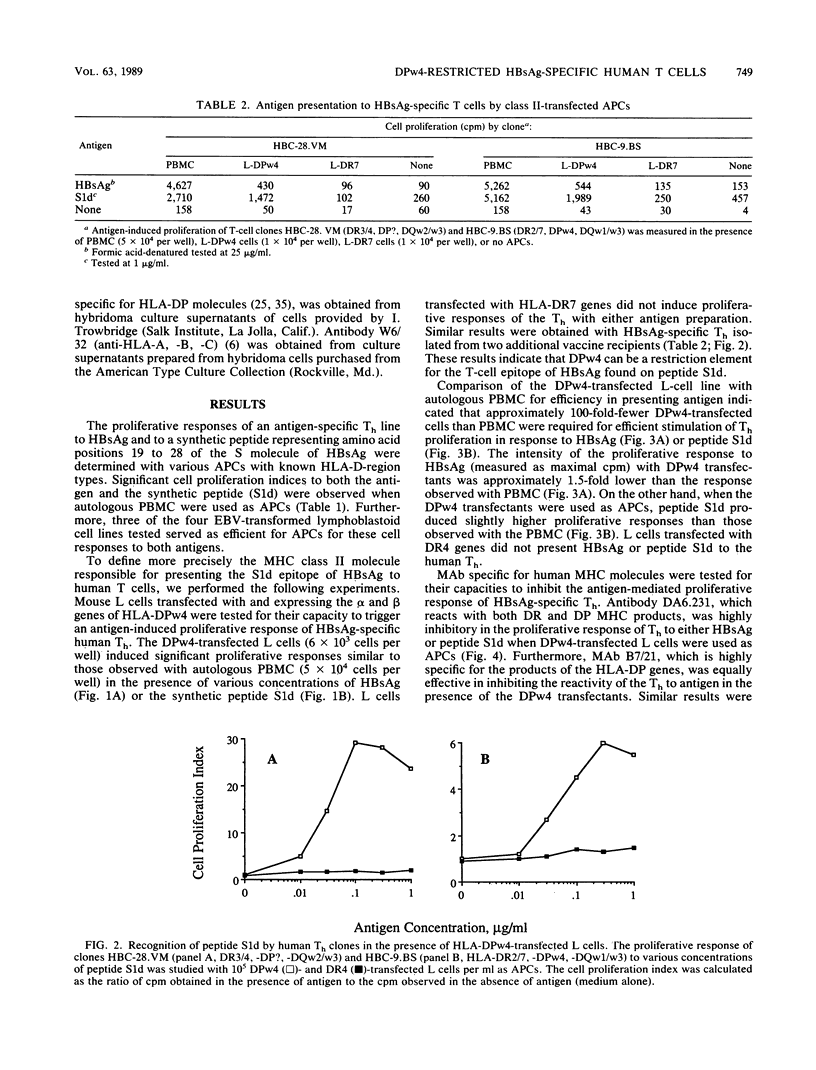
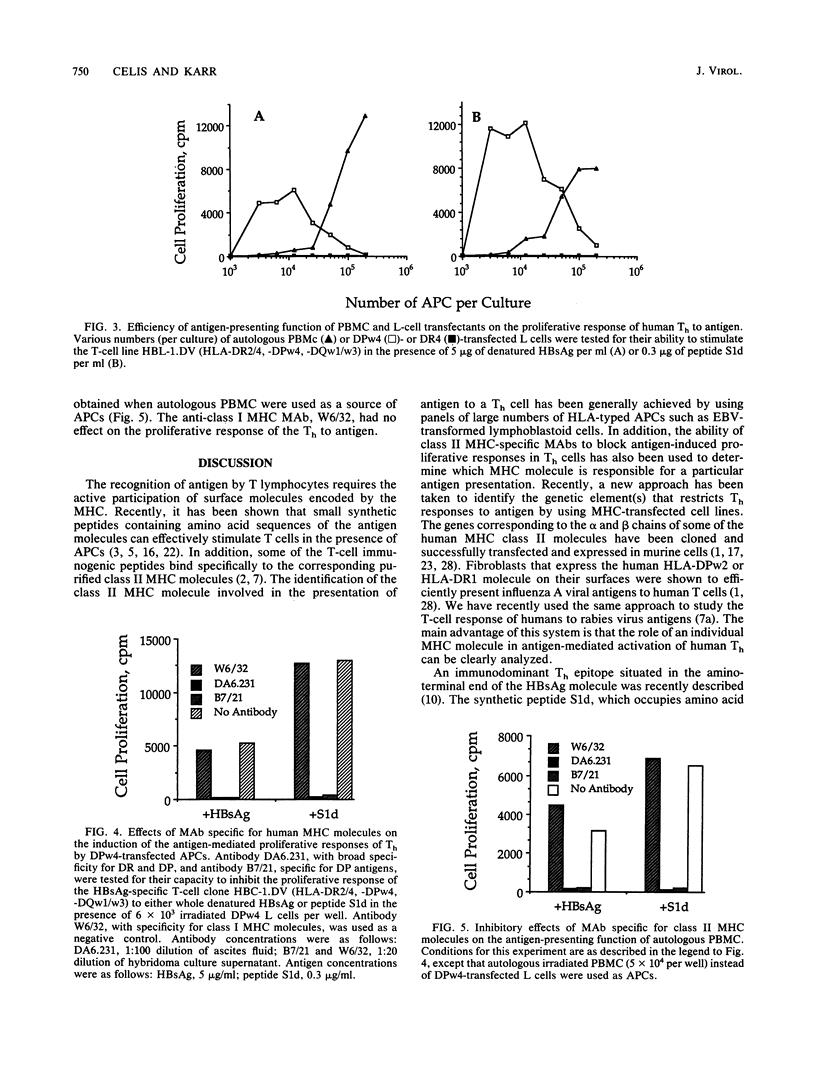
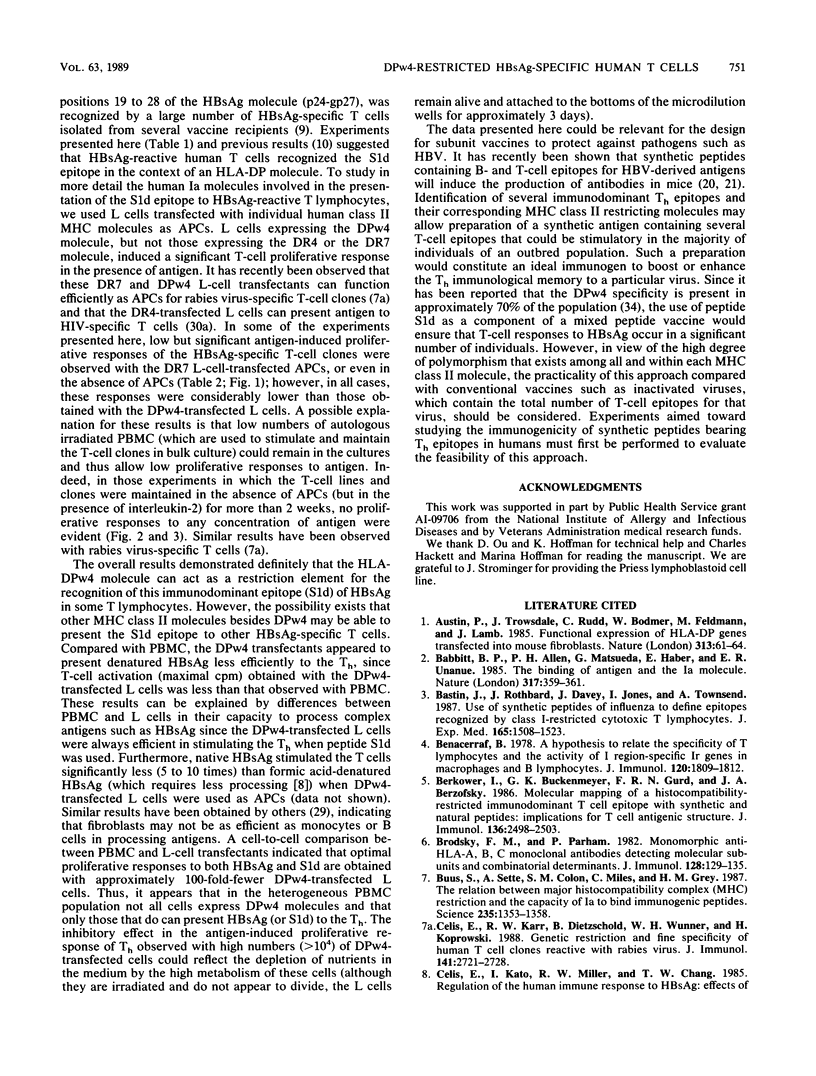
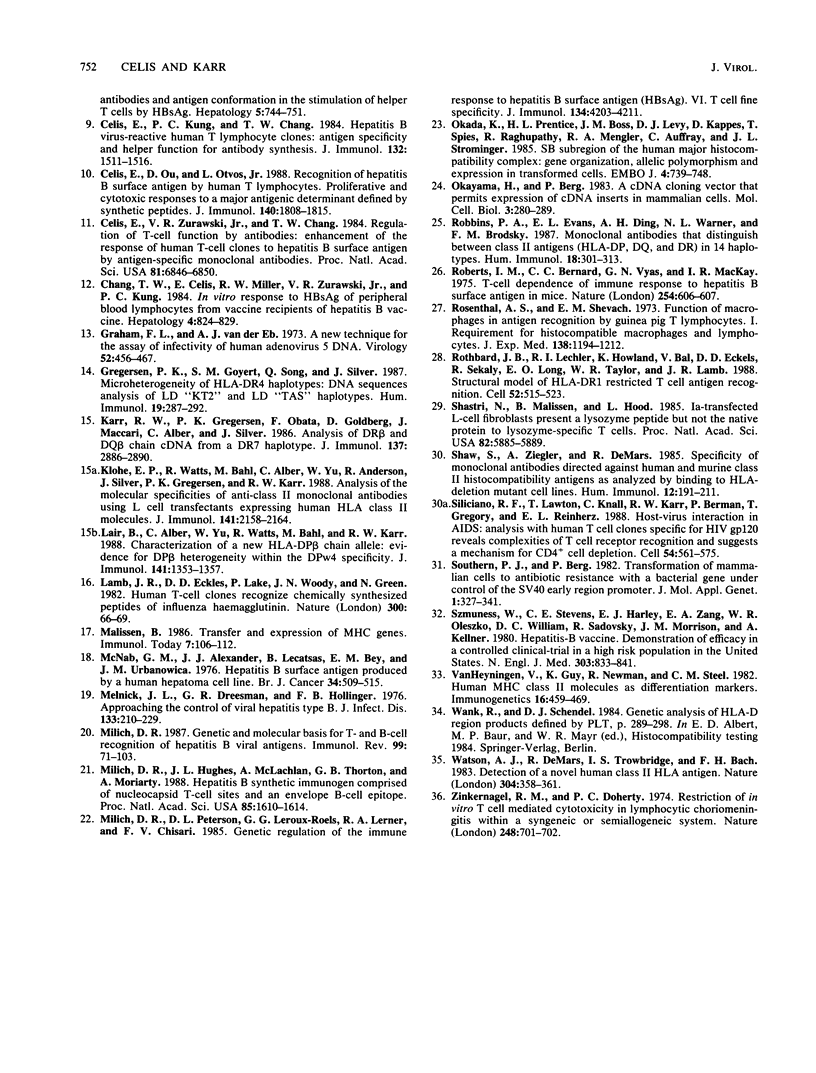
Selected References
These references are in PubMed. This may not be the complete list of references from this article.
- Austin P., Trowsdale J., Rudd C., Bodmer W., Feldmann M., Lamb J. Functional expression of HLA-DP genes transfected into mouse fibroblasts. Nature. 1985 Jan 3;313(5997):61–64. doi: 10.1038/313061a0. [DOI] [PubMed] [Google Scholar]
- Babbitt B. P., Allen P. M., Matsueda G., Haber E., Unanue E. R. Binding of immunogenic peptides to Ia histocompatibility molecules. 1985 Sep 26-Oct 2Nature. 317(6035):359–361. doi: 10.1038/317359a0. [DOI] [PubMed] [Google Scholar]
- Bastin J., Rothbard J., Davey J., Jones I., Townsend A. Use of synthetic peptides of influenza nucleoprotein to define epitopes recognized by class I-restricted cytotoxic T lymphocytes. J Exp Med. 1987 Jun 1;165(6):1508–1523. doi: 10.1084/jem.165.6.1508. [DOI] [PMC free article] [PubMed] [Google Scholar]
- Benacerraf B. A hypothesis to relate the specificity of T lymphocytes and the activity of I region-specific Ir genes in macrophages and B lymphocytes. J Immunol. 1978 Jun;120(6):1809–1812. [PubMed] [Google Scholar]
- Berkower I., Buckenmeyer G. K., Berzofsky J. A. Molecular mapping of a histocompatibility-restricted immunodominant T cell epitope with synthetic and natural peptides: implications for T cell antigenic structure. J Immunol. 1986 Apr 1;136(7):2498–2503. [PubMed] [Google Scholar]
- Brodsky F. M., Parham P. Monomorphic anti-HLA-A,B,C monoclonal antibodies detecting molecular subunits and combinatorial determinants. J Immunol. 1982 Jan;128(1):129–135. [PubMed] [Google Scholar]
- Buus S., Sette A., Colon S. M., Miles C., Grey H. M. The relation between major histocompatibility complex (MHC) restriction and the capacity of Ia to bind immunogenic peptides. Science. 1987 Mar 13;235(4794):1353–1358. doi: 10.1126/science.2435001. [DOI] [PubMed] [Google Scholar]
- Celis E., Karr R. W., Dietzschold B., Wunner W. H., Koprowski H. Genetic restriction and fine specificity of human T cell clones reactive with rabies virus. J Immunol. 1988 Oct 15;141(8):2721–2728. [PubMed] [Google Scholar]
- Celis E., Kung P. C., Chang T. W. Hepatitis B virus-reactive human T lymphocyte clones: antigen specificity and helper function for antibody synthesis. J Immunol. 1984 Mar;132(3):1511–1516. [PubMed] [Google Scholar]
- Celis E., Ou D., Otvos L., Jr Recognition of hepatitis B surface antigen by human T lymphocytes. Proliferative and cytotoxic responses to a major antigenic determinant defined by synthetic peptides. J Immunol. 1988 Mar 15;140(6):1808–1815. [PubMed] [Google Scholar]
- Celis E., Zurawski V. R., Jr, Chang T. W. Regulation of T-cell function by antibodies: enhancement of the response of human T-cell clones to hepatitis B surface antigen by antigen-specific monoclonal antibodies. Proc Natl Acad Sci U S A. 1984 Nov;81(21):6846–6850. doi: 10.1073/pnas.81.21.6846. [DOI] [PMC free article] [PubMed] [Google Scholar]
- Chang T. W., Celis E., Miller R. W., Zurawski V. R., Jr, Kung P. C. In vitro response to HBsAg of peripheral blood lymphocytes from recipients of hepatitis B vaccine. Hepatology. 1984 Sep-Oct;4(5):824–829. doi: 10.1002/hep.1840040504. [DOI] [PubMed] [Google Scholar]
- Graham F. L., van der Eb A. J. A new technique for the assay of infectivity of human adenovirus 5 DNA. Virology. 1973 Apr;52(2):456–467. doi: 10.1016/0042-6822(73)90341-3. [DOI] [PubMed] [Google Scholar]
- Gregersen P. K., Goyert S. M., Song Q. L., Silver J. Microheterogeneity of HLA-DR4 haplotypes: DNA sequence analysis of LD"KT2" and LD"TAS" haplotypes. Hum Immunol. 1987 Aug;19(4):287–292. doi: 10.1016/0198-8859(87)90046-2. [DOI] [PubMed] [Google Scholar]
- Karr R. W., Gregersen P. K., Obata F., Goldberg D., Maccari J., Alber C., Silver J. Analysis of DR beta and DQ beta chain cDNA clones from a DR7 haplotype. J Immunol. 1986 Nov 1;137(9):2886–2890. [PubMed] [Google Scholar]
- Klohe E. P., Watts R., Bahl M., Alber C., Yu W. Y., Anderson R., Silver J., Gregersen P. K., Karr R. W. Analysis of the molecular specificities of anti-class II monoclonal antibodies by using L cell transfectants expressing HLA class II molecules. J Immunol. 1988 Sep 15;141(6):2158–2164. [PubMed] [Google Scholar]
- Lair B., Alber C., Yu W. Y., Watts R., Bahl M., Karr R. W. A newly characterized HLA-DP beta-chain allele. Evidence for DP beta heterogeneity within the DPw4 specificity. J Immunol. 1988 Aug 15;141(4):1353–1357. [PubMed] [Google Scholar]
- Lamb J. R., Eckels D. D., Lake P., Woody J. N., Green N. Human T-cell clones recognize chemically synthesized peptides of influenza haemagglutinin. Nature. 1982 Nov 4;300(5887):66–69. doi: 10.1038/300066a0. [DOI] [PubMed] [Google Scholar]
- MacNab G. M., Alexander J. J., Lecatsas G., Bey E. M., Urbanowicz J. M. Hepatitis B surface antigen produced by a human hepatoma cell line. Br J Cancer. 1976 Nov;34(5):509–515. doi: 10.1038/bjc.1976.205. [DOI] [PMC free article] [PubMed] [Google Scholar]
- Melnick J. L., Dreesman G. R., Hollinger F. B. Approaching the control of viral hepatitis type B. J Infect Dis. 1976 Feb;133(2):210–229. doi: 10.1093/infdis/133.2.210. [DOI] [PubMed] [Google Scholar]
- Milich D. R. Genetic and molecular basis for T- and B-cell recognition of hepatitis B viral antigens. Immunol Rev. 1987 Oct;99:71–103. doi: 10.1111/j.1600-065x.1987.tb01173.x. [DOI] [PubMed] [Google Scholar]
- Milich D. R., Hughes J. L., McLachlan A., Thornton G. B., Moriarty A. Hepatitis B synthetic immunogen comprised of nucleocapsid T-cell sites and an envelope B-cell epitope. Proc Natl Acad Sci U S A. 1988 Mar;85(5):1610–1614. doi: 10.1073/pnas.85.5.1610. [DOI] [PMC free article] [PubMed] [Google Scholar]
- Milich D. R., Peterson D. L., Leroux-Roels G. G., Lerner R. A., Chisari F. V. Genetic regulation of the immune response to hepatitis B surface antigen (HBsAg). VI. T cell fine specificity. J Immunol. 1985 Jun;134(6):4203–4211. [PubMed] [Google Scholar]
- Okada K., Prentice H. L., Boss J. M., Levy D. J., Kappes D., Spies T., Raghupathy R., Mengler R. A., Auffray C., Strominger J. L. SB subregion of the human major histocompatibility complex: gene organization, allelic polymorphism and expression in transformed cells. EMBO J. 1985 Mar;4(3):739–748. doi: 10.1002/j.1460-2075.1985.tb03691.x. [DOI] [PMC free article] [PubMed] [Google Scholar]
- Okayama H., Berg P. A cDNA cloning vector that permits expression of cDNA inserts in mammalian cells. Mol Cell Biol. 1983 Feb;3(2):280–289. doi: 10.1128/mcb.3.2.280. [DOI] [PMC free article] [PubMed] [Google Scholar]
- Robbins P. A., Evans E. L., Ding A. H., Warner N. L., Brodsky F. M. Monoclonal antibodies that distinguish between class II antigens (HLA-DP, DQ, and DR) in 14 haplotypes. Hum Immunol. 1987 Apr;18(4):301–313. doi: 10.1016/0198-8859(87)90077-2. [DOI] [PubMed] [Google Scholar]
- Roberts I. M., Bernard C. C., Vyas G. N., Mackay I. R. T-cell dependence of immune response to hepatitis B antigen in mice. Nature. 1975 Apr 17;254(5501):606–607. doi: 10.1038/254606a0. [DOI] [PubMed] [Google Scholar]
- Rosenthal A. S., Shevach E. M. Function of macrophages in antigen recognition by guinea pig T lymphocytes. I. Requirement for histocompatible macrophages and lymphocytes. J Exp Med. 1973 Nov 1;138(5):1194–1212. doi: 10.1084/jem.138.5.1194. [DOI] [PMC free article] [PubMed] [Google Scholar]
- Rothbard J. B., Lechler R. I., Howland K., Bal V., Eckels D. D., Sekaly R., Long E. O., Taylor W. R., Lamb J. R. Structural model of HLA-DR1 restricted T cell antigen recognition. Cell. 1988 Feb 26;52(4):515–523. doi: 10.1016/0092-8674(88)90464-3. [DOI] [PubMed] [Google Scholar]
- Shastri N., Malissen B., Hood L. Ia-transfected L-cell fibroblasts present a lysozyme peptide but not the native protein to lysozyme-specific T cells. Proc Natl Acad Sci U S A. 1985 Sep;82(17):5885–5889. doi: 10.1073/pnas.82.17.5885. [DOI] [PMC free article] [PubMed] [Google Scholar]
- Shaw S., Ziegler A., DeMars R. Specificity of monoclonal antibodies directed against human and murine class II histocompatibility antigens as analyzed by binding to HLA-deletion mutant cell lines. Hum Immunol. 1985 Apr;12(4):191–211. doi: 10.1016/0198-8859(85)90336-2. [DOI] [PubMed] [Google Scholar]
- Siliciano R. F., Lawton T., Knall C., Karr R. W., Berman P., Gregory T., Reinherz E. L. Analysis of host-virus interactions in AIDS with anti-gp120 T cell clones: effect of HIV sequence variation and a mechanism for CD4+ cell depletion. Cell. 1988 Aug 12;54(4):561–575. doi: 10.1016/0092-8674(88)90078-5. [DOI] [PubMed] [Google Scholar]
- Southern P. J., Berg P. Transformation of mammalian cells to antibiotic resistance with a bacterial gene under control of the SV40 early region promoter. J Mol Appl Genet. 1982;1(4):327–341. [PubMed] [Google Scholar]
- Szmuness W., Stevens C. E., Harley E. J., Zang E. A., Oleszko W. R., William D. C., Sadovsky R., Morrison J. M., Kellner A. Hepatitis B vaccine: demonstration of efficacy in a controlled clinical trial in a high-risk population in the United States. N Engl J Med. 1980 Oct 9;303(15):833–841. doi: 10.1056/NEJM198010093031501. [DOI] [PubMed] [Google Scholar]
- Watson A. J., DeMars R., Trowbridge I. S., Bach F. H. Detection of a novel human class II HLA antigen. 1983 Jul 28-Aug 3Nature. 304(5924):358–361. doi: 10.1038/304358a0. [DOI] [PubMed] [Google Scholar]
- Zinkernagel R. M., Doherty P. C. Restriction of in vitro T cell-mediated cytotoxicity in lymphocytic choriomeningitis within a syngeneic or semiallogeneic system. Nature. 1974 Apr 19;248(5450):701–702. doi: 10.1038/248701a0. [DOI] [PubMed] [Google Scholar]
- van Heyningen V., Guy K., Newman R., Steel C. M. Human MHC class II molecules as differentiation markers. Immunogenetics. 1982;16(5):459–469. doi: 10.1007/BF00372104. [DOI] [PubMed] [Google Scholar]


